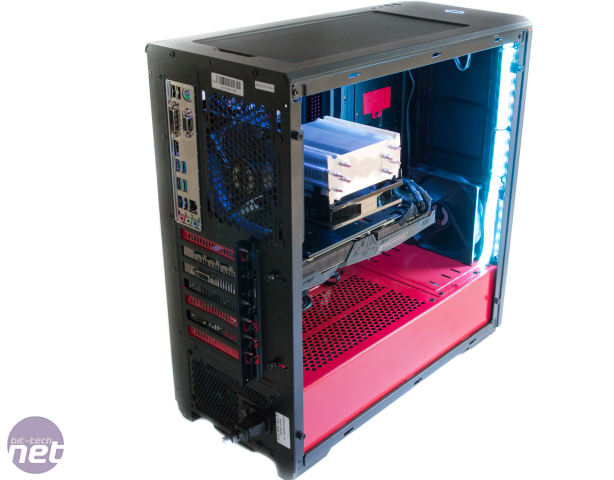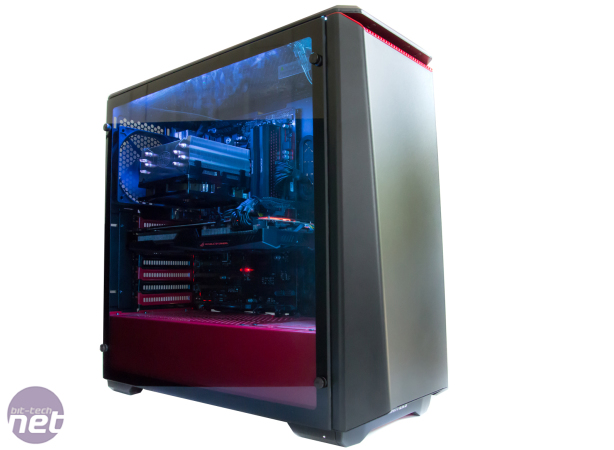
Performance Analysis
We'll start with thermals, and the graphics card was supremely cool and quiet throughout testing, peaking at a delta T of 44°C and a GPU-Z reported temperature of 70°C. The CPU was pretty toasty under full load with a vcore of 1.38V pushing the AMD Ryzen Master temperature reading to 91°C, although this was also with the graphics card dishing out heat in Unigine Valley, so these aren't the kind of temperatures you'd see in games. Even so, the Cooler Master cooler is probably near its limits in this situation.At higher resolutions, any deficits due to lingering Ryzen optimisation issues are very thin, with the GTX 1080 powering its way to results we'd expect from this powerful GPU. In fact, it was faster in both our game tests than the Corsair One Pro, which has a stock speed Core i7-7700K and a liquid-cooled GTX 1080, edging it out by a few frames per second in each test. Only the DinoPC C3 Mod Gaming PC was faster, and this sports an overclocked GTX 1080 and a 4.8GHZ Core i7-7700K.
We're phasing out the PCMark 8 Video Editing test, as it only uses two threads and seems to be very Intel-optimised, which does explain why the overclocked Ryzen 7 1700 didn't do so well. However, in HandBrake, it was faster than an Intel Core i7-6900K, and even when the latter was ovcerclocked to 4.2GHz, the AMD CPU was only a few seconds behind. The system's multi-threaded performance was cemented in Terragen 4 where the time of 171 seconds was faster than all the other results on test, and it picked up the highest score in Cinebench too.
The storage performance was on the money for a Samsung PCI-E M.2 SSD, and while the SM961 isn't as rapid as a 960 Pro of the same capacity, it's still able to dish out huge numbers. One blip was a low result in the 4KB random speed test in CrystalDiskMark, but all other numbers were excellent. Power consumption was reasonable given we're dealing with an overclocked, eight-core CPU and a high-end graphics card that itself features above-stock frequencies, but there's still plenty of headroom for adding more components.
Conclusion
Adding all the components up we come to a retail price of between £1,600 and £1,700. For that you're getting Windows pre-installed, and the system tweaked to offer 3,200MHz memory and a 3.8GHz overclock from its powerful eight-core Ryzen 7 1700, with a three-year warranty thrown in too. As usual, then, in value terms, things are pretty good, as you can't build the system for less yourself. In performance terms, things are good too. Gaming performance is excellent, and anywhere that the CPU's cores are used it blitzes Intel quad-cores, making this a great machine for anyone thinking of video editing, rendering, or streaming.There are a couple of niggles, though, which mean the Titan Katana Ryzen missed out on our top award. The case fans are set to maximum, but Overclockers UK has at least said it will remedy that issue with retail systems following feedback from this review. The CPU cooler is perhaps a little lowly given the price tag and is at its limits in extreme situations. This isn't helped by the fact there's no fan behind it - only to the side at the rear, although this is perhaps being mindful of the fact that people leave magazines and the like on top of their PCs, which could hamper cooling a lot more. However, for normal use in demanding games and applications, things are spot on, and cable tidying is excellent. It's a good looking PC, and the hardware is pretty much exactly what we'd choose ourselves with a modern storage setup and the latest AMD gear.


MSI MPG Velox 100R Chassis Review
October 14 2021 | 15:04










Want to comment? Please log in.